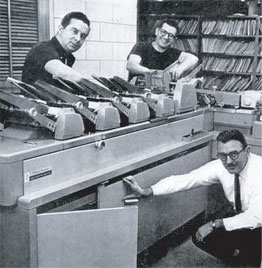One thing jumps out:
Could the letters have been mailed from Mare Island?
Zip prefix 966 would theoretically fit the bill.
…
966: US Military Bases, Naval/Marine
I am, personally, quite drawn to this idea as a possibility. If at all feasible, it would potentially tie up a number of loose ends. Not least, it would go some way to explaining the evident (from GeoProfiling) familiarity with the Vallejo area, but at the same time not require regular trips into San Francisco to send letters.
The only thought I have at this point in time against this idea – and it is potentially a big one – is that the mail would have to have been processed first through the Navy mail system, even if only minimally, and the envelopes were marked so distinctively that they would surely (after the first few) have been intercepted at source.
It’s possible there was extra Navy processing. But it’s also quite possible a USPS truck drove onto the base every day, emptied the USPS mailboxes, and drove the mail to the central processing center in San Francisco, just as would have apparently been done with mail in San Mateo and Santa Clara counties.
<So, as others have said, the letter/number on the Zodiac postmarks are service marks that merely indicate by which machine inside the post office the letter was cancelled. I suspect the reason these numbers also have letters is because they were processed at a very large post office with many machines.>
Not sure the Reddit answer makes sense, because too many Z letters had 1s and 6s, correct? That would be out of proportion to a facility with 30+ cancelling stations, each with a different number.
Also the Reddit person said the additional letter code would be unusual. All of this is at odds with Shaq’s source, who I believe said the number represents the type of cancelling machine, and the letter represents the type of dye.
the letter represents the type of dye.
I believe it’s actually a "die" not a "dye".
A "die" is defined as "any of various tools or devices for imparting a desired shape, form, or finish to a material or for impressing an object or material" – like a postmark on a letter for example.
“Murder will out, this my conclusion.”
– Geoffrey Chaucer
Thanks for the dye/die clarification.
Now that we have that straight, what next?
I just spoke on the phone to a gentleman named Matthew Liebson who is the president of the International Machine Cancel Society. Per their website, they are "dedicated to the study of Machine Postal Markings, the Machine Inventors, Patents, and other Related History".
Here is what he had to say after he looked over the envelopes and postmarks related to the Zodiac:
The numbers and letters are, in fact, service markers. All of the postmarks and cancellations in the Zodiac correspondence were made by a Pitney Bowes Mark II face cancelling machine which was one of the most common of that time. These machines were quite large and contained anywhere from 4 to 8 "heads". The numbers on the Zodiac letters referred to the head used in which machine. Each head contained two dies, either A or B. So the letter referred to which die was used. For example, "1B" would refer to "Head #1, Die B"
Mr. Liebson explained that the letters would be collected and taken to a "main processing center" which housed dozens of these Pitney Bowes Mark II cancelling machines where they would be run through, postmarked, and cancelled.
I asked him if letters from particular post offices or dropboxes would be sorted through particular machines. Unfortunately, he said no. It is a totally random process. He concluded our conversation by saying that there would be no information on the envelopes that would give any indication as to the origin of the letter – except a return address of course.
The bottom line, I’m afraid, is that we have hit a dead end. We have exhausted our efforts and there is simply no way to figure out where each letter was mailed from.
It was a great effort by everyone. While unsuccessful in its original aims, we have decisively debunked a long-running belief that those letters and numbers were district codes. They were not, and that in itself is something.
“Murder will out, this my conclusion.”
– Geoffrey Chaucer
Great work with this interview. Did he say why some letters had no two-digit codes?
Shaq, I believe the zone chart you posted applies to parcels (packages). I’m quite sure in 1969 that a letter mailed anywhere in the US cost the same.
(A letter mailed from Vallejo to Vallejo would cost the same as a letter mailed from Vallejo to New York City.)
Yes, that is what I seemed to have discovered after looking a little more closely. I have to be honest, I was a little confused for a while, so thanks for confirming that.
So the first class rates for the period we are interested in are (from Wikipedia: History of US postage rates):
- From 07 Jan 1968: 6c for the first ounce; 6c per additional ounce; 5c postcard rate;[/*:m:37cohodf][*]From 16 May 1971: 8c for first ounce; 8c each additional; 6c postcards;[/*:m:37cohodf][*]From 02 Mar 1974: 10c first ounce; 10c each additional; 8c postcards.[/*:m:37cohodf][/list:u:37cohodf]
- 408 letter to SF Examiner, 31/07/1969: 2 x 6c;[/*:m:37cohodf]
- 408 letter to Vallejo Times-Herald, 31/07/1969: 4 x 6c;[/*:m:37cohodf]
- 408 letter to SF Chronicle, 31/07/1969: 2 x 6c;[/*:m:37cohodf]
- ‘Good times in Vallejo’ letter to SF Examiner, 04/08/1969: —[/*:m:37cohodf]
- ‘Stine’ letter to SF Chronicle, 13/10/1969: 2 x 6c;[/*:m:37cohodf]
- ‘Dripping Pen’ letter + Z340 to SF Chronicle, 08/11/1969: 2 x 6c;[/*:m:37cohodf]
- ‘Bus Bomb’ letter to SF Chronicle, 09/11/1969: 2 x 6c;[/*:m:37cohodf]
- Belli letter, 20/12/1969: 6 x 1c;[/*:m:37cohodf]
- ‘My name is…’ letter + Z13 to SF Chronicle, 20/04/1970: 2 x 6c;[/*:m:37cohodf]
- ‘Dragon’ card to SF Chronicle, 28/04/1970: 2 x 6c;[/*:m:37cohodf]
- Letter + Z32 to SF Chronicle, 26/06/1970: 1 x 6c;[/*:m:37cohodf]
- ‘Kathleen Johns’ letter to SF Chronicle, 24/07/1970: 1 x 6c;[/*:m:37cohodf]
- ‘Little List’ letter to SF Chronicle, 26/07/1970: 1 x 6c;[/*:m:37cohodf]
- ‘13-hole’ postcard, 05/10/1970: 1 x 6c;[/*:m:37cohodf]
- ‘Halloween’ card to SF Chronicle, 27/10/1970: 1 x 6c;[/*:m:37cohodf]
- ‘Riverside Activity’ letter to LA Times, 13/03/1971: 2 x 6c;[/*:m:37cohodf]
- ‘Pines’ postcard to SF Chronicle, 23/03/1971: 4c pre-cancelled;[/*:m:37cohodf]
- ‘Exorcist’ letter to SF Chronicle, 29/01/1974: 1 x 8c[/*:m:37cohodf][/list:u:37cohodf]
A list of the postage applied to each of the letters up to the Exorcist letter would then be (note: UK date format DD/MM/YYYY):
So. What does the overpostage tell us from this?
Certainly, there seems to be a general pattern – double postage (mainly) initially, then apparently getting the hang of all this postage-by-weight and calming down a bit after mid-1970?
But, maybe that’s for a different thread, given that – as Chaucer points out – this one does seem to have reached its goal, pretty much.
“This isn’t right! It’s not even wrong!”—Wolfgang Pauli (1900–1958)
Great work with this interview. Did he say why some letters had no two-digit codes?
These particular face cancelling machines had, at the most, 8 heads. So the highest number you would expect to see on any postmark would 8.
I have attached a picture of the type of machine Zodiac’s correspondence would have been run through. This one has four heads.
“Murder will out, this my conclusion.”
– Geoffrey Chaucer
Great work with this interview. Did he say why some letters had no two-digit codes?
These particular face cancelling machines had, at the most, 8 heads. So the highest number you would expect to see on any postmark would 8.
I have attached a picture of the type of machine Zodiac’s correspondence would have been run through. This one has four heads.
Right, but doesn’t the Belli letter for example contain no such 2-digit code, even though it is also postmarked San Francisco?
I’m wondering what your source’s explanation would be for that.
Right, but doesn’t the Belli letter for example contain no such 2-digit code, even though it is also postmarked San Francisco?
I’m wondered what your source’s explanation would be for that.
Now that is an excellent observation. Maybe we’re not quite done yet.
Was there, perhaps, some scenario in which a definitely-local letter dropped at a small post office might still be hand-cancelled without being sent round the Sectional Center processing route?
“This isn’t right! It’s not even wrong!”—Wolfgang Pauli (1900–1958)
Right, but doesn’t the Belli letter for example contain no such 2-digit code, even though it is also postmarked San Francisco?
I’m wondered what your source’s explanation would be for that.
Now that is an excellent observation. Maybe we’re not quite done yet.
Was there, perhaps, some scenario in which a definitely-local letter dropped at a small post office might still be hand-cancelled without being sent round the Sectional Center processing route?
Yes, one could and can certainly walk up to a post office window and hand your letter to a clerk, who will typically hand postmark it with a wooden hand-stamp and an ink pad.
Right, but doesn’t the Belli letter for example contain no such 2-digit code, even though it is also postmarked San Francisco?
Okay. So, I’ve just gone through the postmarks on the letters again and, apparently, there are three that don’t show the 2-digit machine code:
These are:
[list=1]
“This isn’t right! It’s not even wrong!”—Wolfgang Pauli (1900–1958)
Hand cancellations as opposed to machine.
Just thinking out loud for a moment, to try and see what we might have here.
So. It looks like it has been ascertained that the bulk of the Zodiac mailings were processed through the Sectional Center Facility in the usual manner and would have been dropped in a mailbox somewhere in the broad region of San Francisco, Santa Clara, San Mateo and very possibly Mare Island. As these make up the majority of the mailings, it seems fair to assume that these were mailed in a manner to fit in with his regular life pattern, including work.
Now, if the idea that is starting to form is correct – that three of the letters were very likely hand-cancelled at a post office – then wouldn’t the most logical conclusion be that, at these times, the sender was in some way outside of his "regular life pattern, including work." Basically, on leave?
Now, if he lived in any of San Francisco, Santa Clara or San Mateo, then this would make no difference whatsoever. He’d still be able to walk out of his home and drop the letter in a mailbox and still get a San Francisco postmark. So, could this (hypothetical) scenario suggest that he perhaps doesn’t live in any of these broad areas?
If, on the other hand, he is someone who worked or was stationed at Mare Island and lived in Vallejo, perhaps in the Naval homes of Federal Terrace, he would have a bit of a problem during periods of leave. He would no longer be able to walk to a nearby postbox and mail the letter, because now it would get a Solano postmark. So, some other method of posting would need to be used.
Again, this is just thinking out loud. But I am, personally, starting to think there is some important information to gain from the fact that three of his letters were hand-cancelled, suggesting at the very least (IMHO) some or other change of routine around the times of the 09 Nov 1969, 20 Dec 1969 and 26 July 1970 mailings.
Certainly, if there was some merit in supposing he was in the USN, for example, and these were periods of leave, then this would be a crucial bit of information in narrowing down a suspect pool.
“This isn’t right! It’s not even wrong!”—Wolfgang Pauli (1900–1958)



